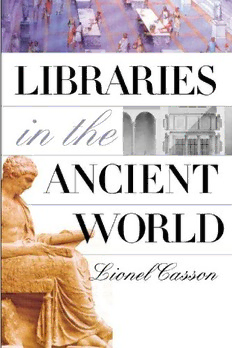
Libraries in the Ancient World PDF
Preview Libraries in the Ancient World
Libraries in the Ancient World Libraries in the Ancient World LIONEL CASSON YALENOTABENE Yale University Press/New Haven and London First published as a Yale Nota Bene book in 2002. Hardcover edition first published by Yale University Press in 2001. Copyright © 2001 by Yale University. All rights reserved. This book may not be reproduced, in whole or in part, including illustrations, in any form (beyond that copying permitted by Sections 107 and 108 of the U.S. Copyright Law and except by reviewers for the public press), without written permission from the publishers. For information about this and other Yale University Press publications, please contact: U.S. office [email protected] Europe office [email protected] Printed in the United States of America The Library of Congress has cataloged the hardcover edition as follows: Casson, Lionel, 1914– Libraries in the ancient world / Lionel Casson. p. cm. Includes bibliographical references and index. ISBN 0-300-08809-4 (alk. paper) 1. Libraries—History—To 400. I. Title. Z722. C37 2001 027(cid:2).09—dc21 00-011668 ISBN 0-300-09721-2 (pbk.) A catalogue record for this book is available from the British Library. 10 9 8 7 6 5 4 3 2 1 To Judy Contents Preface ix Maps xi, xii 1.The Beginnings: The Ancient Near East 1 2.The Beginnings: Greece 17 3.The Library of Alexandria 31 4.The Growth of Libraries 48 5.The Beginnings: Rome 61 6.Libraries of the Roman Empire: The City of Rome 80 7.Libraries of the Roman Empire: Outside the City of Rome 109 8.From Roll to Codex 124 9.Toward the Middle Ages 136 Abbreviations 147 Notes 149 List of Illustrations 167 Index 171 Preface This book is the first full-scale study of libraries in the ancient world. It presents whatever is known about them from their debut in the ancient Near East in the third millennium B.C.down to the early Byzantine period, the fourth and fifth centuries A.D., when the spread of Christianity and of monasticism fundamentally changed the course of library history. Ancient writings contain only haphazard bits of information about libraries. To fill out the picture we must turn to a variety of sources. One of the most helpful is archaeology: at a number of sites excavation has laid bare library remains, and these give us an idea, in some cases a fairly good idea, of the physical facilities. In- scriptions relating in one way or another to libraries, from decrees honoring wealthy benefactors to epitaphs on the gravestones of humble employees, provide welcome detail on important aspects. But there are certain matters, such as the nature of the holdings in the various libraries, the readership they served, the way they made their acquisitions, their methods for shelving and catalogu- ing, and so on, for which we are reduced to inference based on faint clues, or even, at times, to pure speculation. The book is addressed to both general readers and scholars. For the latter I have supplied, in a section at the back, complete docu- mentation; it is keyed to the statements concerned by means of page references and brief clues rather than footnote numbers to avoid the distraction these can cause. It was Harry Haskell of Yale University Press who suggested the idea of a book on ancient libraries, and I am deeply grateful for his ix
